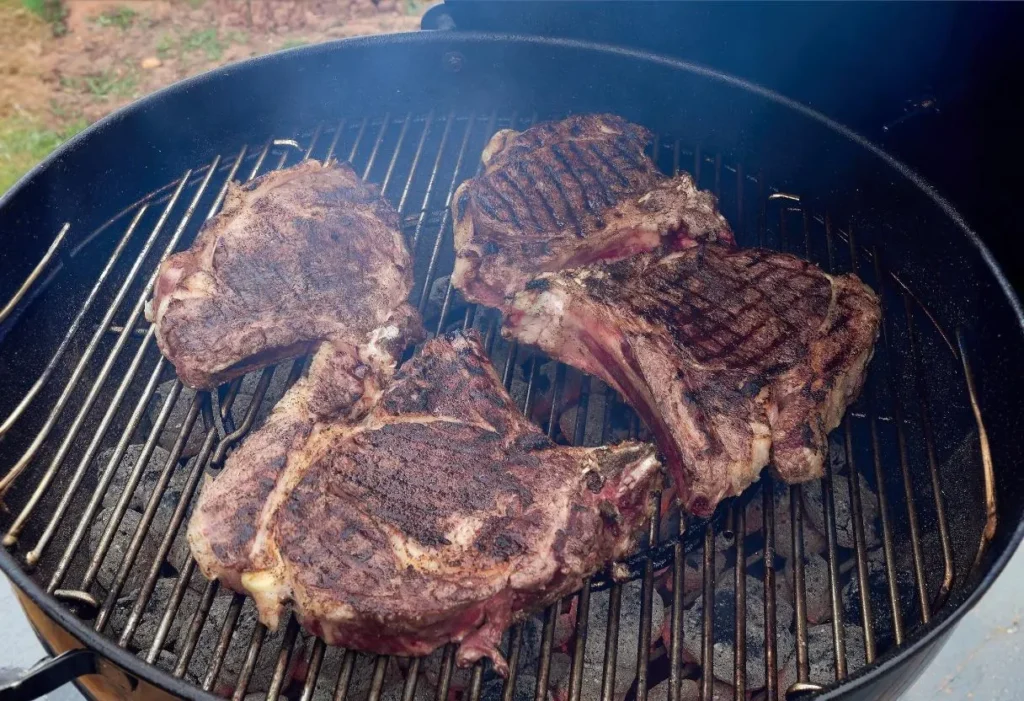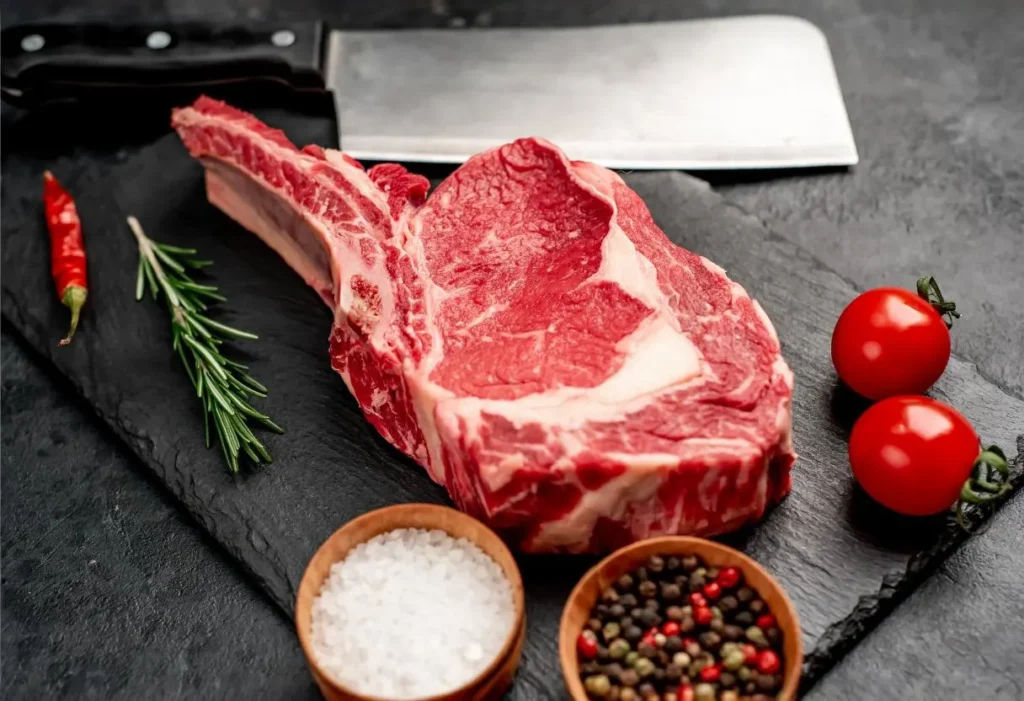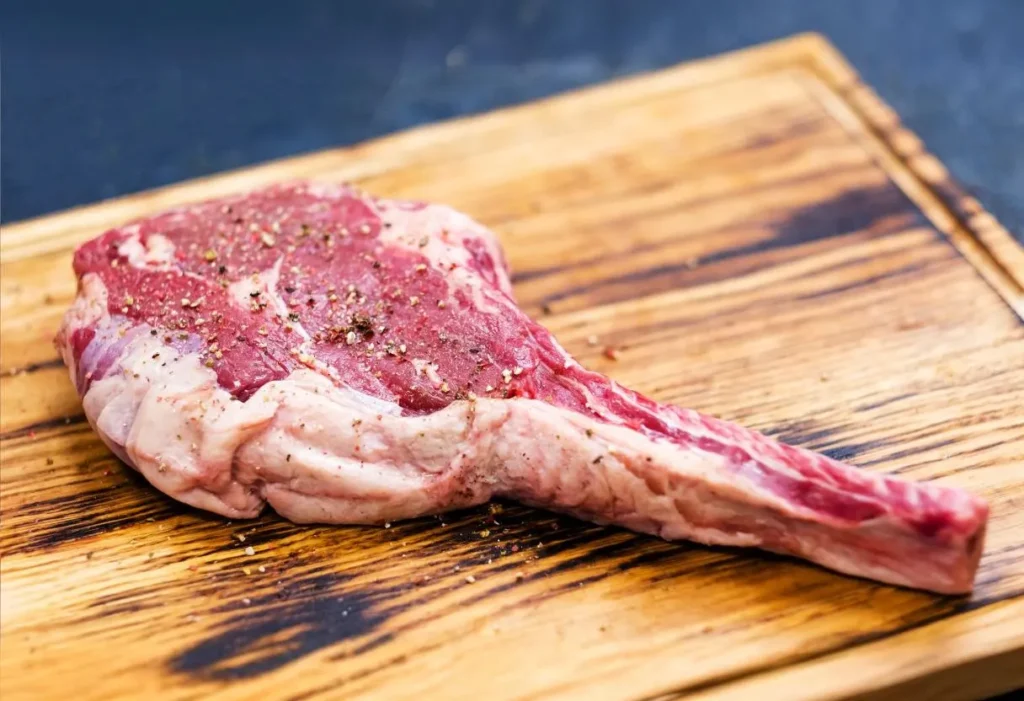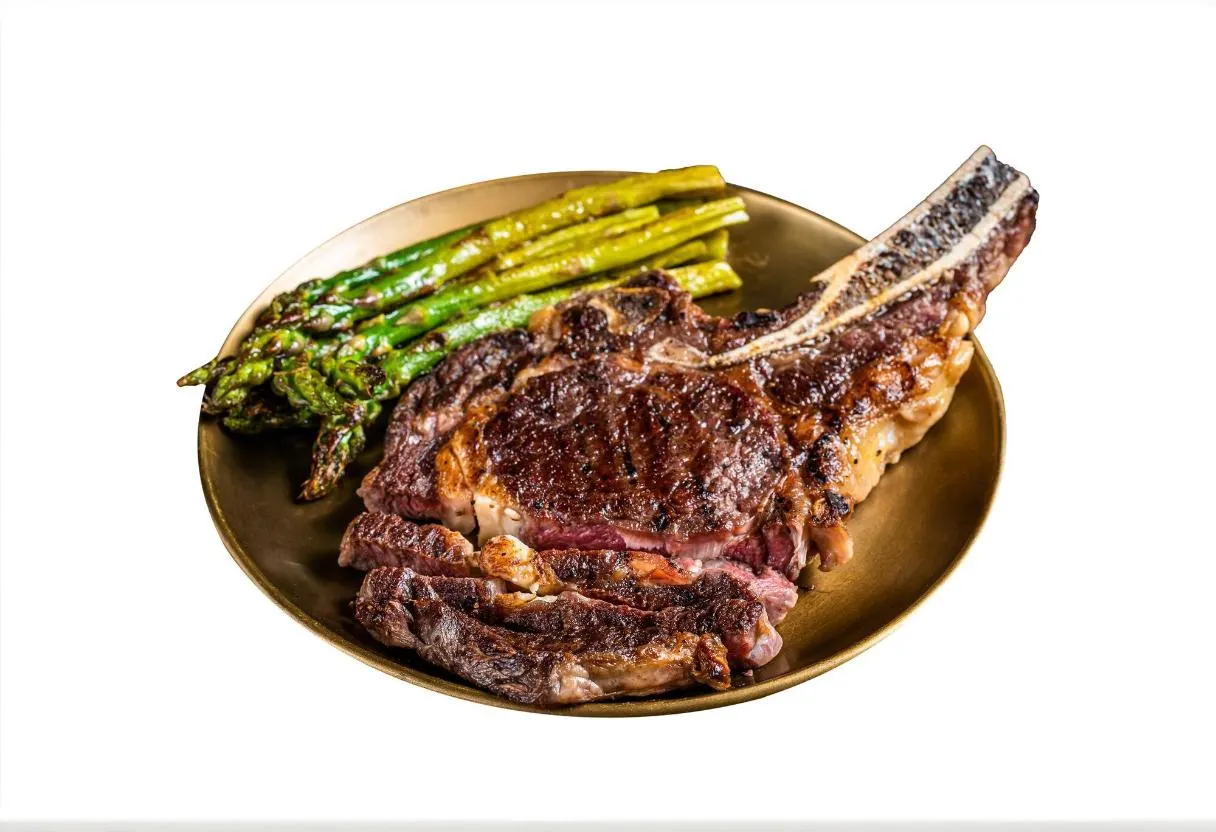Discover the rustic charm, cooking tips, and flavorful secrets behind the iconic cowboy steak.
Introduction
Cowboy steak has long captured the imagination of meat enthusiasts around the United States. This hearty, bone-in ribeye cut delivers an unforgettable taste, thanks to its exceptional marbling and striking presentation. In fact, many steak lovers describe the cowboy steak as the ultimate combination of tenderness, robust flavor, and visual flair. Therefore, it is not surprising that it stands out on restaurant menus and family dinner tables alike.
If you want to expand your culinary horizons even further after reading this guide, consider exploring some of our other meaty articles like Mastering Bottom Round Roast or understanding unique cuts in Delmonico Steak: History, Preparation, Cooking. In addition, for those interested in hearty sandwich ideas, check out The Ultimate Brisket Sandwich Guide. However, let us now turn our attention to the distinctive cowboy steak and uncover everything you need to know about this flavorful star of the steak world.
In this in-depth article, we will explore the cowboy steak’s history, what makes it so special, how to choose a prime cut, and effective cooking methods to create restaurant-quality results in your own kitchen. Along the way, we will also discuss healthy serving ideas, proper resting times, essential seasonings, and common pitfalls to avoid. Finally, you will find a detailed recipe with clear step-by-step cooking instructions that simplifies the process for beginners, yet proves endlessly rewarding for experienced chefs. Let us saddle up and begin our flavorful journey.
Table of Contents
History and Origins of Cowboy Steak
Throughout the American West, few images evoke the spirit of the frontier more than cowboys gathered around a campfire, savoring a hearty slab of beef. The cowboy steak, also referred to as a “bone-in ribeye,” draws inspiration from that era when ranchers prioritized wholesome, satisfying meals after a long day of tending cattle. However, its roots stretch farther back.

Influence of Ranch Culture
Cattle drives in the 19th century provided ample opportunities for developing flavorful cuts. The ribeye section, particularly, boasted excellent marbling and retained moisture during cooking. Therefore, it quickly gained recognition among ranch hands for delivering protein-packed meals in a small portion of time. Over time, the name “cowboy steak” stuck, reflecting both the rugged persona of cattlemen and the big flavor associated with the cut.
From Campfire to Gourmand Table
Eventually, as beef production expanded, restaurants across the U.S. began highlighting cowboy steaks on their menus. Chefs recognized that the bone, left attached to the ribeye, not only made a visual statement but also contributed to the overall succulence. Consequently, the cowboy steak shifted from a ranch staple to a gourmet showpiece. Today, restaurants consistently feature it as a premium option, highlighting its natural juiciness and tender bite.
Understanding the Cowboy Steak Cut
To master cooking a cowboy steak, it is essential to understand its characteristics. After all, not every thick ribeye steak you encounter will truly qualify as a cowboy cut.
Bone-In Ribeye Excellence
In practical terms, a cowboy steak is a bone-in ribeye, typically trimmed with a portion of the rib bone exposed. For many steak enthusiasts, the primary appeal lies in the bone’s contribution to flavor and moisture retention. During the cooking process, the bone helps insulate the meat, creating more even heating and helping the natural juices remain intact.
Key Attributes
- Thickness: Cowboy steaks are usually cut at least 1.5 to 2 inches thick.
- Marbling: They come from the primal rib section, known for intermuscular fat, which translates into tenderness and rich taste.
- Presentation: The rib bone acts as a handle, giving the cut a rustic, eye-catching appeal.
Because of these qualities, cowboy steaks are often the centerpiece at gatherings or served as a luxurious treat at upscale steakhouses. However, you can certainly recreate this restaurant-level grandeur at home by carefully selecting and preparing the cut.
Selecting the Perfect Cowboy Steak
Finding the ideal cowboy steak depends on several factors, including quality grades, feeding practices, and personal preferences. Therefore, before you visit your local butcher or grocery store, it helps to know what to look for.

USDA Grades
In the United States, the Department of Agriculture (USDA) assigns quality grades to beef based on marbling and age:
- Prime: The highest grade, featuring abundant marbling and tenderness. Often found in specialty markets and upscale restaurants.
- Choice: Next tier with slightly less marbling than Prime, still delivering excellent flavor and texture. Widely available at supermarkets.
- Select: Less intramuscular fat, often leaner and less flavorful than higher grades.
Although Prime cuts are costlier, they promise a distinctive succulence that many steak enthusiasts deem well worth the investment.
Grass-Fed vs. Grain-Fed
You may encounter grass-fed cowboy steaks, which generally have a more pronounced, almost earthy flavor and leaner texture. On the other hand, grain-fed beef usually exhibits richer marbling and a slightly sweeter taste. Therefore, if you prefer a robust flavor and leaner bite, grass-fed might be the better choice. Conversely, grain-fed cowboy steak will likely deliver a richer mouthfeel and enhanced juiciness.
Thickness Matters
Since cowboy steak is all about savoring each bite’s bold flavor, thickness is crucial. Opt for steaks that measure at least 1.5 inches. Anything thinner may overcook more easily, robbing you of the tender interior that epitomizes this cut. Therefore, always confirm thickness with your butcher if you are not certain.
Preparing a Cowboy Steak
Before you heat up the grill or skillet, you will want to make sure that your cowboy steak is properly prepped. Preparation includes seasoning, marination choices, and gathering the right tools.

Seasoning the Cowboy Steak
- Classic Salt and Pepper: Sometimes the best approach is the simplest. Generously coat your cowboy steak with coarse salt and freshly ground pepper. This enhances the natural taste without overshadowing the beef’s intrinsic flavor.
- Dry Rubs: If you crave a more adventurous twist, consider blending garlic powder, onion powder, paprika, and a hint of chili powder. Gently pat this mixture into the steak’s surface for an aromatic crust.
- Herb Infusions: Fresh rosemary, thyme, or oregano can also be pressed onto the surface. Their oils blend with the steak’s fats during cooking, creating a delightfully herbaceous aroma.
Marinades
Although not always necessary for a well-marbled cut like a cowboy steak, marinades can add an extra dimension of flavor. For example, soy sauce, Worcestershire sauce, or a simple olive oil and herb mixture can be used. However, it is wise to avoid overly acidic marinades that might break down the steak’s fibers and alter its texture too severely.
Essential Tools
- Meat Thermometer: Helps achieve your desired level of doneness.
- Tongs: Prevents piercing the meat, which can cause precious juices to escape.
- Cast-Iron Skillet (if pan-searing): Retains high heat, creating an exceptional crust.
- Instant-Read Probe: Assures consistent internal temperatures throughout.
Pre-Cooking Recommendations
- Room Temperature: Take the steak out of the fridge 30–45 minutes prior to cooking. This promotes even cooking.
- Pat Dry: Moisture on the surface can inhibit browning. Gently pat away any excess liquid.
- Oil: Lightly coat the steak or cooking surface with a high smoke-point oil (like vegetable oil).
Cooking Techniques for a Perfect Cowboy Steak
Cowboy steak is versatile and accommodates several cooking methods. Regardless of your approach—grill, pan, or reverse sear—the key lies in controlling heat effectively and gauging the steak’s internal temperature.
H2: Grilling a Cowboy Steak
Grilling remains one of the most popular ways to cook a cowboy steak. The open flame imparts a smoky taste that complements the natural beefiness.
- Preheat the Grill: Aim for high heat to sear the outside rapidly. You will often set up two heat zones—a hotter side for searing and a cooler side for finishing the cooking process.
- Sear the Steak: Place your cowboy steak over direct heat, searing each side for about 2–3 minutes until a crust forms.
- Move to Indirect Heat: Transfer the steak to the cooler side and continue cooking until the internal temperature reaches your preferred doneness (130°F for medium-rare).
- Rest: Remove the steak from the grill and tent it with foil. Let it rest for 5–10 minutes to ensure the juices redistribute evenly.
H2: Reverse Searing a Cowboy Cut Steak
For those who appreciate a precise, evenly-cooked interior, reverse searing works wonders. Therefore, this method involves slowly bringing the steak to temperature, then finishing it with a high-heat sear.
- Warm in the Oven: Preheat your oven to about 250°F. Place your seasoned cowboy steak on a wire rack atop a baking sheet.
- Check Internal Temperature: Bake until the steak’s internal temperature hits 115–120°F.
- High-Heat Sear: Immediately sear the steak in a hot cast-iron skillet (or on a blazing grill) for 1–2 minutes per side to form a delicious crust.
- Rest: As with all methods, allow a brief rest before slicing.
H2: Pan-Searing a Bone-In Ribeye
A cast-iron skillet can produce restaurant-quality results. Moreover, pan-searing allows you to regulate the crust formation easily.
- High Heat: Preheat the skillet until it is almost smoking.
- Sear Both Sides: Sear your cowboy steak for about 2–3 minutes per side.
- Oven Finish: If the steak is thicker, transfer the skillet to a preheated 400°F oven for 5–10 minutes or until it reaches the correct internal temperature.
- Rest: Remove from heat and let the cowboy steak rest on a cutting board.
H2: Smoking a Cowboy Steak
Smoking imparts deep, bold flavors. Hickory or mesquite wood chips pair exceptionally well with the robust cowboy steak.
- Prep the Smoker: Keep the temperature between 225–250°F.
- Smoke Until Almost Done: Insert a meat thermometer after about 30 minutes to monitor progress. Cook until within 5–10 degrees of your target temperature.
- Optional Sear: To intensify the crust, finish the steak with a quick sear.
- Rest: Always factor in resting time for optimal juiciness.
Cowboy Steak Recipe: Step-by-Step Guide
This recipe delivers a succulent cowboy steak every time, combining a simple seasoning method with a fail-proof cooking technique. Although we will use a cast-iron skillet and oven finish here, you can adapt it to the grill or reverse sear if you prefer.
Ingredients
- 1 cowboy steak (about 2 inches thick, bone-in ribeye)
- 2 teaspoons coarse salt
- 1 teaspoon freshly ground black pepper
- 1 teaspoon garlic powder (optional)
- 1 tablespoon high smoke-point oil (e.g., canola, avocado)
Expanded Cooking Instructions
- Bring the Steak to Room Temperature
- Take the cowboy steak out of the refrigerator about 45 minutes before you plan to cook. Pat it dry with paper towels to remove excess moisture.
- Season Generously
- Combine salt, pepper, and garlic powder (if using) in a small bowl. Then, rub the mixture evenly across all sides of the steak. Allow the seasoned steak to rest at room temperature, allowing the flavors to penetrate.
- Preheat Your Skillet and Oven
- Meanwhile, preheat your oven to 400°F.
- Place a cast-iron skillet on the stovetop over medium-high heat. Once it is hot, add the tablespoon of oil and swirl to coat the bottom.
- Initial Sear
- Carefully place the cowboy steak in the skillet. You should hear a sizzling sound immediately—this ensures proper browning.
- Sear for about 2–3 minutes, then flip and sear the other side for another 2–3 minutes.
- Oven Finish
- Transfer the cast-iron skillet with the steak into the 400°F oven.
- Cook for about 5–10 minutes, depending on the thickness, until the internal temperature reaches 130°F for medium-rare. If you prefer medium, aim for about 135–140°F.
- Rest and Serve
- Remove the skillet from the oven and move the steak to a cutting board.
- Tent it loosely with foil and let it rest for 5–10 minutes. This step is crucial because it helps the juices redistribute throughout the meat.
- Slice against the grain and serve with your favorite sides.
Because this cut is naturally flavorful, you only need minimal seasoning to highlight its best qualities. However, if you enjoy more complexity, feel free to experiment with rubs featuring paprika, cayenne pepper, or dried herbs.
Complementary Flavors and Sides
Although the cowboy steak holds its own as the star attraction, complementary flavors and side dishes enhance your dining experience even more.
Savory Sauces and Toppings
- Compound Butter: Blend softened butter with chopped herbs (such as parsley, chives, or thyme) and a pinch of salt. Place a generous dollop on the steak just before serving.
- Classic Sauces: Chimichurri or pepper sauce can underscore the steak’s robust flavor. However, use these sparingly to avoid overpowering the beef’s natural goodness.
Wholesome Side Dishes
- Roasted Vegetables: Carrots, bell peppers, zucchini, or onions roasted with olive oil and herbs provide a colorful, nutrient-rich addition.
- Mashed Potatoes: The velvety texture contrasts beautifully with the steak’s hearty bite.
- Crisp Salads: A green salad with fresh tomatoes, onions, and a light vinaigrette cuts through the steak’s richness.
Cowboy Steak for Special Occasions
Hosting a dinner party or celebrating a milestone? Cowboy steak makes a showstopping centerpiece. The bone-in aesthetic exudes rugged charm, while the succulent texture guarantees rave reviews. Therefore, when planning your menu for holidays like Father’s Day, Fourth of July, or birthdays, consider spotlighting the cowboy steak. It pairs well with a range of sides, from mac and cheese to grilled corn on the cob, ensuring a memorable feast.
Common Mistakes to Avoid
Cooking a cowboy steak does not have to be challenging, provided you steer clear of typical missteps.
- Skipping the Rest: Cutting into the steak immediately causes the flavorful juices to run off the plate instead of circulating within each bite.
- Overcooking: Because this is a thicker cut, rely on a thermometer to ensure you do not overshoot your target temperature.
- Over-Seasoning: Excessive spice mixes can overpower the natural flavor.
- Neglecting the Bone’s Role: The exposed bone is not just for show; it insulates the meat and contributes to the overall taste.
Nutritional Profile
Although the cowboy steak is undeniably indulgent, it does offer valuable nutrients. Like most cuts of beef, it is a good source of protein, iron, zinc, and B vitamins. The following table provides approximate nutritional content per 100 g of cooked cowboy steak:
| Nutrient | Amount (per 100 g) |
|---|---|
| Calories | ~250 |
| Protein | ~26 g |
| Total Fat | ~16 g |
| Saturated Fat | ~7 g |
| Carbohydrates | 0 g |
| Iron | ~2.2 mg |
| Zinc | ~4.5 mg |
| Vitamin B12 | ~2.0 µg |
Note: Values may vary based on the steak’s grade, feeding method, and cooking technique.
Final Thoughts and Serving Tips
Cooking the perfect cowboy steak requires mindful preparation and attention to detail. First, start by selecting a high-quality cut, ideally with generous marbling and substantial thickness. Then, season it simply, respecting its inherent flavor. Whether you opt for grilling, pan-searing, or reverse searing, timing is crucial. Finally, remember to let the steak rest and pair it with sides that balance its rich, savory presence.
A cowboy steak is more than just a piece of beef—it is an experience that blends history, tradition, and culinary craft. Therefore, the next time you crave a hearty, mouthwatering meal, give this iconic cut a try. You may discover it becomes your new favorite.
FAQ
What cut of meat is cowboy steak?
A cowboy steak is a bone-in ribeye cut, generally thicker than a standard ribeye. It leaves part of the rib bone exposed, contributing both visual appeal and flavor.
What’s the difference between a tomahawk and a cowboy steak?
Both cuts come from the rib primal section. However, a tomahawk steak includes a much longer portion of the rib bone (often 5 or more inches), which is frenched for a more dramatic appearance. Cowboy steaks typically have a shorter bone.
Why is cowboy steak so expensive?
Cowboy steaks usually come from the highest-quality portion of the rib primal and can be graded USDA Prime. Their thick cut, excellent marbling, and eye-catching presentation also drive up the cost.
How to cook a cowboy steak?
Although there are several methods—grilling, pan-searing, reverse searing, and smoking—the general approach is to sear the outside and finish cooking either by indirect heat or in the oven until it reaches your desired level of doneness. Always rest the meat prior to slicing.
Conclusion
The cowboy steak offers a bold, meaty essence that carries echoes of ranch culture and open-fire cooking. Its thick cut, marbling, and bone-in structure combine to yield a flavorful, juicy meal with minimal effort. Therefore, choosing a well-marbled steak, seasoning mindfully, and applying proper cooking techniques will reward you with an unforgettable dish. Moreover, serving it with complementary sides and sauces will further elevate your experience. Ultimately, the cowboy steak is a sumptuous indulgence that brings both rugged flair and refined taste to the table.

